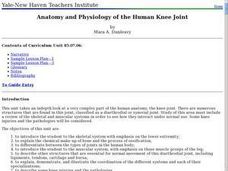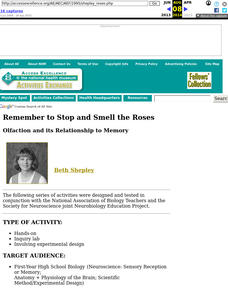Curated OER
Joints Help Us Move
Third graders investigate the three main types of joints in their arms and legs that are in charge of movement. In this human biology instructional activity, 3rd graders view x-rays online to see how different joints look, participate...
Curated OER
Anatomy and Physiology of the Human Knee Joint
Students examine human anatomy with a focus on the knee joint. In groups, they research the chemical makeup of human bones and explain the different types of joints found in the body. To end the lesson, they identify the other structures...
Cornell University
Bridge Building
Bridge the gaps in your knowledge of bridges. Individuals learn about bridge types by building models. The activity introduces beam bridges, arch bridges, truss bridges, and suspension bridges.
Curated OER
The Skeletal System
Third graders are introduced to the human skeletal system. Using play-doh, they discover what happens to the bones of the body as a person moves and how broken bones heal. After reading examples, they examine the different types of...
Curated OER
The Greatest Show on Earth: The World's Smallest Animals
Students create instruments to capture different types of insects. In this The Greatest Show on Earth: The World's Smallest Animals lesson, students compare the attributes of certain insects and record the data on a chart. After catching...
Curated OER
Skeletal System
Seventh graders explore the functions of the skeletal system. They collaborate in small groups to determine the function of the skeletal system, the types of joints and movement, bone strength and growth, and bone injuries including...
Curated OER
Weapons of War
Learners discuss how American and Great Britian attacked Afghanistan after September 11. They analyze different types of aircraft, missiles, and munitiions used in the attacks in Afghanistan.
Statistics Education Web
You Will Soon Analyze Categorical Data (Classifying Fortune Cookie Fortunes)
Would you rely on a fortune cookie for advice? The lesson first requires future statisticians to categorize 100 fortune cookie fortunes into four types: prophecy, advice, wisdom, and misc. The lesson goes on to have learners use...
Curated OER
Invent an Insect
Explore biology by researching adaptation. First, learners research and define a list of insect vocabulary terms and discuss the benefits of each insect characteristic. They then utilize a worksheet to create their own insect and share...
Curated OER
Types of Legs
Students identify the characteristics of the legs of arthropods as well as how they are used. They compare and contrast the legs of various types of bugs in the arthropod family. A comparison worksheet is included in with this lesson.
Curated OER
Head, Shoulders, Knees and Toes
Students gain a greater comprehension of the anatomy and physiology of the muscular system, the skeletal system and connective tissue by researching joints in the body. They also reflect on the effects of injuries on their joints and...
Curated OER
Anne Frank: Movement - Isometric Exercises
Third graders review the main points in the novel, "Anne Frank: The Diary of a Young Girl". Using the text of their hiding, they explain the need for a healthy diet and movement for proper health. In groups, they practice different...
Curated OER
SA/V Ratio and Rate of Diffusion
High schoolers calculate the SA/V ratio and volume of phenophthalien agar that are cut into different shapes. They then let ammonia diffuse into the various pieces of agar and determine the effect that SA/V had on the rate of diffusion.
American Statistical Association
A Sweet Task
Candy is always an effective motivator! A fun math activity uses M&M's and Skittles to explore two-way frequency tables and conditional probability. The candy can serve a dual purpose as manipulatives and experimental data.
Curated OER
Underwater Research
Students make transect and quadrat surveys using a provided worksheet in order to understand the techniques used to study coral reefs. Each type of survey is used to identify the species, diversity, and number of corals.
Curated OER
What Can We Learn From Bones?
Students discuss what type of information they can gather from bones. In groups, they travel between stations in which they can view photos and listen to actual accounts of finding bones. They focus on the tools available to Native...
Curated OER
An Arm and A Leg
Students examine how the movements of bones are dependent on the interaction of pairs of muscles. They design and construct a prototype of an artificial limb using a syringe system, and determine whether water or air makes the appendage...
Curated OER
Skin: Skin Prints
Learners explore human anatomy by participating in a print experiment. In this human skin lesson, students define the term "epidermis" and utilize computer paper, pencils, tape and baby wipes to create a print of their own skin. Learners...
Curated OER
Surface Friction and Wear Characteristics of Common Materials
Students identify the factors affecting friction. In this physics instructional activity, students construct their own rocket car and race them. They graph the average speeds and discuss how lubricants affect friction between rubbing...
Curated OER
Remember to Stop and Smell the Roses: Olfaction and its Relationship to Memory
Students discover that olfaction elicits memory associations. They investigate how olfaction compares to other sensory modalities in the formation of memories. This is a hands-on lab activity guaranteed to build memories in your students!
Curated OER
Diversity And Adaptations Of Organisms
Seventh graders demonstrate the processes of science by posing questions and investigating phenomena through language, methods and instruments of science. They study the body features or systems of several animals.
Curated OER
Candy Quakes
Eighth graders use candy to show the effects of deformation forces on the earth's crust. In this rock and fossil formation instructional activity students construct models and simulations to describe and explain natural phenomena.























